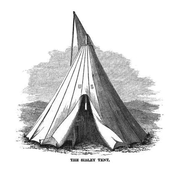
Sibley tent
Encyclopedia

People of the United States
The people of the United States, also known as simply Americans or American people, are the inhabitants or citizens of the United States. The United States is a multi-ethnic nation, home to people of different ethnic and national backgrounds...
military officer Henry Hopkins Sibley
Henry Hopkins Sibley
Henry Hopkins Sibley was a brigadier general during the American Civil War, leading the Confederate States Army in the New Mexico Territory. His attempt to gain control of trails to California was defeated at the Battle of Glorieta Pass...
and patented in 1856. Of conical design, it stands about twelve feet high and eighteen feet in diameter. It can comfortably house about a dozen men.
The Sibley design differed from other conical tents, or bell tents of the times (see photograph below) in a number of ways. Sibley's design was supported by a central pole which would telescope down into the supporting tripod so that it took less space to pack and store. The tripod could be erected over a firepit for cooking and heat. The Sibley design also required no guy ropes, being held down by twenty-four pegs around the base. Additionally, unlike earlier designs, the use of a cowl over the central pole allowed for ventilation and for the escape of smoke, regardless of wind direction.
History

Utah War
The Utah War, also known as the Utah Expedition, Buchanan's Blunder, the Mormon War, or the Mormon Rebellion was an armed confrontation between LDS settlers in the Utah Territory and the armed forces of the United States government. The confrontation lasted from May 1857 until July 1858...
during the winter of 1857-58, proving the design. Several of the Plains Indian Wars veterans noted the tent's similarity to Indian lodges
Tipi
A tipi is a Lakota name for a conical tent traditionally made of animal skins and wooden poles used by the nomadic tribes and sedentary tribal dwellers of the Great Plains...
—the smoke hole, the tent peg
Tent peg
A tent peg is a spike, usually with a hook or hole on the top end, typically made from wood, metal, plastic, or composite material, pushed or driven into the ground for holding a tent to the ground, either directly by attaching to the tent's material, or by connecting to ropes attached to the tent...
s around the outer edge, the fire pit, etc.
In accordance with an 1858 agreement with the Department of War
United States Department of War
The United States Department of War, also called the War Department , was the United States Cabinet department originally responsible for the operation and maintenance of the United States Army...
, Sibley would have received $5 USD for every tent made. However, Sibley resigned from the US Army to join the Confederate States Army
Confederate States Army
The Confederate States Army was the army of the Confederate States of America while the Confederacy existed during the American Civil War. On February 8, 1861, delegates from the seven Deep South states which had already declared their secession from the United States of America adopted the...
after the outbreak of the American Civil War
American Civil War
The American Civil War was a civil war fought in the United States of America. In response to the election of Abraham Lincoln as President of the United States, 11 southern slave states declared their secession from the United States and formed the Confederate States of America ; the other 25...
. He received no royalties
Royalties
Royalties are usage-based payments made by one party to another for the right to ongoing use of an asset, sometimes an intellectual property...
on his patent. The Union Army produced and used nearly 44,000 Sibley tents during the war.
After Sibley's death, his relatives attempted unsuccessfully to collect the royalties from the Department of Defense.

